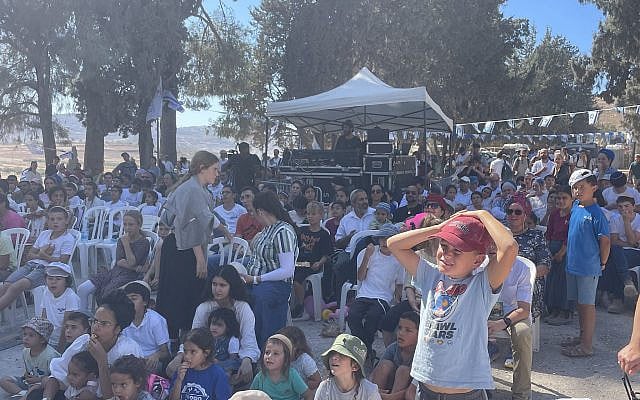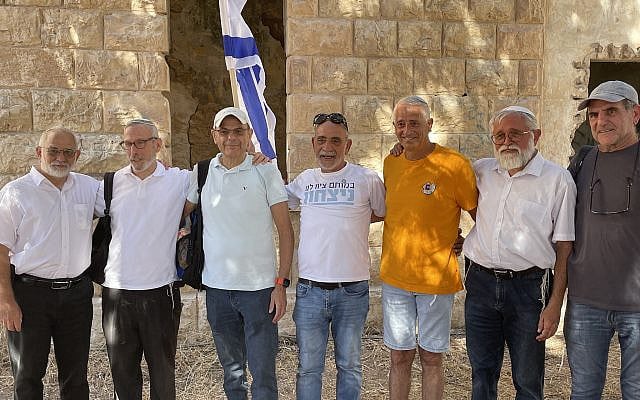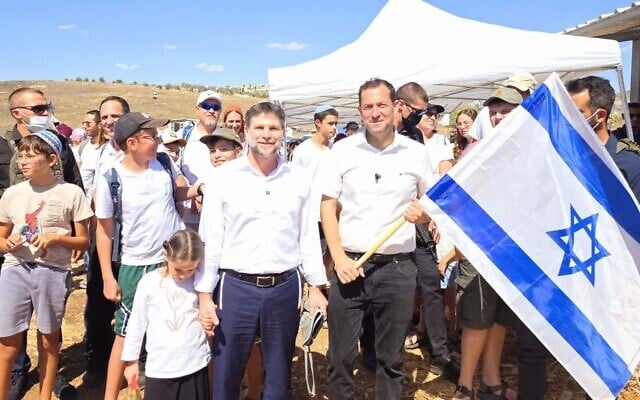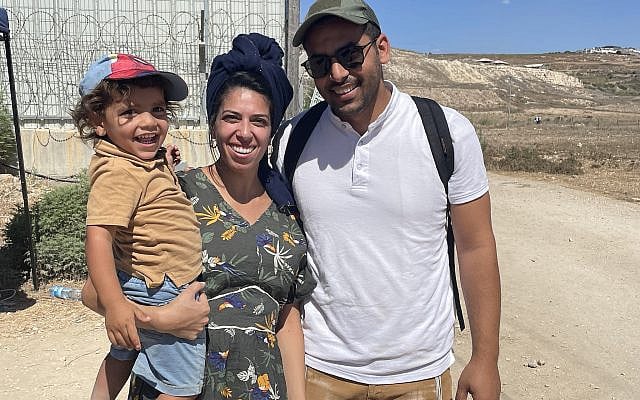

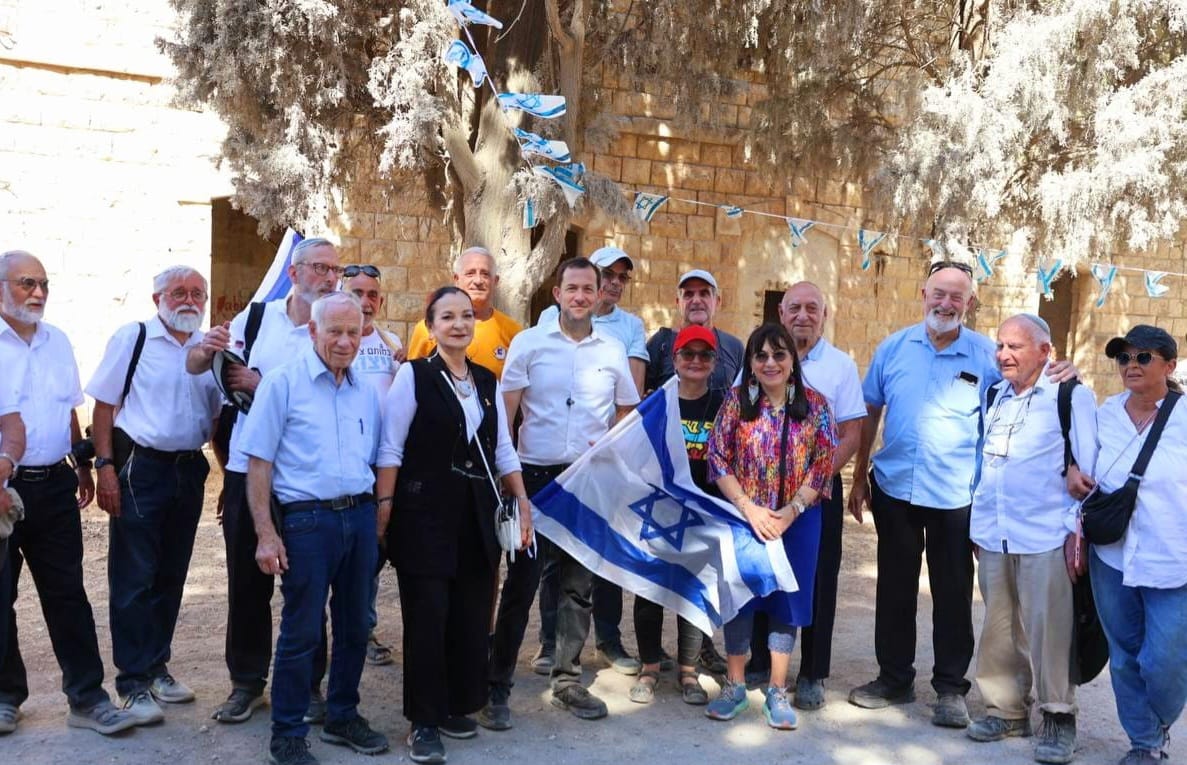
Sebastia in the northern West Bank has, for the last half-century, aroused passions among the settler community and in Israel more broadly, owing to the historic campaign of the Gush Emunim movement to establish the first settlement there in late 1975.
On Wednesday morning, drawing inspiration from that portentous event, the Samaria District Council held a celebration marking 50 years of settlement in the Samaria region in the northern West Bank, and to “draw strength” for another half-century of settlement endeavor.
Young families with children of all ages engaged in a reenactment of the march the early settler activists performed, stopping at various stations along the way to learn about the history — ancient and modern — of the region.
Fittingly, the three-kilometer (1.86-mile) trail started at the site of the illegal settlement outpost of Elhai and wound its way up to the old Sebastia train station, where the original activists had camped out to demand the establishment of a civilian settlement in the region.
Revelers celebrated at the end of the trail amid a carnival atmosphere replete with stilt walkers, bouncy castles and cotton candy, while a local troupe performed some biblical cosplay to reenact stories from the times of ancient Israel.
Accompanying the merrymaking was a sharp political message, with senior politicians addressing a rally in front of the old train station and vowing to see through the vision of their Gush Emunim forebearers and annex the entire territory.
Starting in 1974, activists from Gush Emunim staged a series of efforts to establish a settlement in the area close to the ruins of ancient Sebastia. The campaign came to a head in late November 1975, when some 2,000 activists marched to the Ottoman-era train station and camped out there for days in the face of government opposition and the constant threat of removal by the IDF.
After ten days, a compromise was finally reached by which the activists could establish a civilian presence in the IDF outpost at nearby Kadum, which became the first civilian settlement in the Samaria region, today named Kedumim.
Yitzhak Kraus was in Grade 12 at the time in a yeshiva high school of the religious Zionist Bnei Akiva movement in Netanya. His school principal decided to bring the class to Sebastia as part of the effort to settle there.
“We were here for nearly two weeks. In the morning we learned Talmud and in the afternoon mathematics. That was the schedule,” Kraus recalled while standing in front of the famed train station where he had camped out in a sleeping bag under the stars five decades ago.
Kraus, who is today an ordained rabbi and professor of Jewish thought at Bar Ilan University, said that when he was a child he had been saddened by the fact that he did not live in the era of the Jewish underground in the era of the British Mandate.
Going to Sebastia had been for him a way of contributing to the Zionist endeavor in a similar vein to his heroes in the Irgun and Lehi underground groups who fought the British in the pre-state era.
“It was exciting. When you see a group of people with you, you understand that you’re part of something big — this is one of the things that gives a person a sense of significance,” said Kraus.
“We understood that we were making a big contribution, although I’m not sure we understood the dimensions at that point.”
The inspiration of the Sebastia moment and its impact on the future of the settlement movement were expressed repeatedly on Wednesday, by the political leaders who spoke at the event and by those who brought their families to experience it.
Addressing the crowd, far-right Finance Minister Bezalel Smotrich, a resident of Kedumim, declared that no one would have believed that in 50 years after the establishment of Kadum there would be over half a million settlers living in hundreds of settlements and outposts dotting the West Bank.
“The great lesson we take from the generation of giants is that you need a vision, you need dreams, you need faith, and most of all you need readiness for hard work, and when you have all those things, dreams are realized and turn into reality,” said the far-right minister, who has himself greatly increased the number of housing units approved for construction in the settlements, and the amount of land appropriated for settlement development, during his time in office.
The march to Sebastia and the establishment of Kedumim was indeed a watershed moment for the settlement movement in general, and in the northern West Bank in particular, and paved the way for the the creation of dozens more settlements in the Samaria region alone.
Although the events of 1975 at Sebastia did not directly impact the Palestinian village of the same name, Palestinian and Israeli civil rights groups maintain that it did have an immediate effect on other local villages, whose agricultural and pasture land was appropriated for the establishment of Kedumim, including, in some instances, private Palestinian land, according to the B’tselem civil rights group.
More generally, the events at Sebastia gave rise to the restrictions and impediments to everyday life that many Palestinians experience as a result of the development of West Bank settlements, such as difficulty accessing land, and friction with the army and extremist settlers.
The lessons for settlement development that Smotrich said had been learned from the events of Sebastia were repeated by many among the droves of people who hiked in the hot sun up to the historic site.
“We came here to show the children how one establishes a new settlement in Samaria,” said Haim, a middle-aged resident of the Peduel settlement who had come with his wife and children to the event.
“There were some smart people who managed to get here [50 years ago], and we can learn from their success.”
Ohad Shlomo, a 33-year-old from the nearby settlement of Einav, said he had brought his young family to take inspiration not only from the early settler activists but from “the land, the broad spaces, from history and from the Bible.”
The commitment to the settlement movement runs deep, he explained, maintaining that Jewish life is intimately bound up in the land.
“This is our life, the Land of Israel, the Holy Land… The land is an inseparable part of the people. There are no people without the land,” he said.
Asked where the Palestinians fit into the vision of a West Bank under full Israeli sovereignty, dominated by ever-expanding settlements, the hikers on the Sebastia march were all equally adamant that there was no room for Palestinian national aspirations in the territory.
“It’s not a problem that they live here, but it is a problem that they have national aspirations and national sentiment, which has no place here… it contradicts us being here and the fact that this is our place,” said Haim.
He said that the Palestinians needed to “abandon” their notions of “national consciousness,” although he was uncertain as to what civil rights such people would have within the Greater Israel of the settlement movement’s vision.
Shlomo was similarly uncompromising in his view that there is no possibility the Palestinians can ever have political independence in the West Bank, stating bluntly that “they have no national rights here.”
He said that his many stints in reserve military duty in Gaza since the October 7, 2023, Hamas atrocities had reinforced this position.
“In every home you enter in Gaza, you see pictures of al-Quds [Jerusalem] and [a map of] the whole of the land. We are not a factor in the equation for them,” charged Shlomo.
“If we make concessions, our enemies see that the Land of Israel isn’t important to us, and they want more and more.
“History teaches us that when we go backwards, we are less secure. When we run away from the Land of Israel our enemies persecute us more and want to kill us,” he said.
Other Arab countries “that are so supportive and loving, and send aid, and shout and protest” could absorb Palestinians, he added scornfully, a sentiment repeated by other participants on the hike.
David Manchovski, the soft-spoken 30-year-old founder of the Elhai outpost, put it in the starkest terms.
“Israel belongs to the people of Israel,” he said. “It’s ours according to God. We hope the day will come when Israel will rule all the land and that the Arabs will accept their rulers. There is no space for a Palestinian state in this country.”


